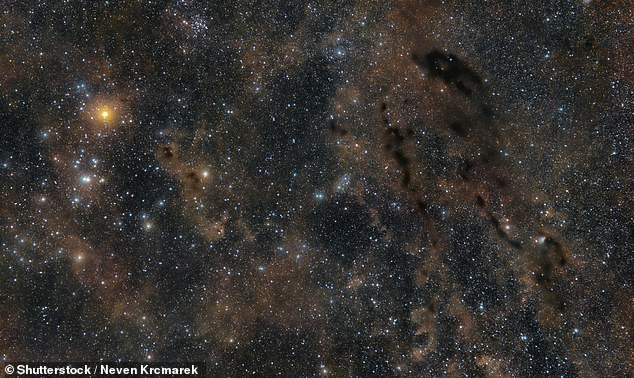Invisible ‘galactic lump’ of dark matter with mass of 10million Suns is making nearby stars disappear, scientists say
- V-cluster of stars known as the Hyades is being ‘gravitationally ripped apart’
- Scientists from the European Space Agency say the culprit is a dark matter lump
- The cluster can be seen with the naked eye on the head of constellation Taurus
Scientists believe the closest star cluster to the Sun is being ripped apart by an enormous invisible mass.
Researchers say the area known as the Hyades, a V-shaped cluster of stars through the head of the constellation Taurus, is being gravitationally ripped apart.
The cluster is about 700million years old and located 153 light-years away from Earth at about 60 light-years across.
But the team says it used to have thousands more stars which have mysteriously disappeared.

The Hyades star cluster collided with an unseen object 10million times bigger than the Sun, says scientists
They believe the cluster encountered an enormous unseen structure measuring roughly 10 million times the mass of the Sun hundreds of millions of years ago which got to work ripping it apart.
One possible explanation is that it was a dark matter halo- an invisible cloud of particles believed to be relics from the formation of the Milky Way Galaxy.
The work was published in Astronomy & Astrophysics earlier this week.
Scientists led by research fellow Tereza Jerabkova from the European Space Agency (ESA) and the European Southern Observatory made the discovery while examining the Hyades cluster using data collected by ESA’s Gaia satellite.
Tereza said: ‘There must have been a close interaction with this really massive clump, and the Hyades just got smashed.
‘With Gaia, the way we see the Milky Way has completely changed. And with these discoveries, we will be able to map the Milky Way’s sub-structures much better than ever before.’
Star clusters naturally lose stars because they tug at each other gravitationally which changes their velocities, moving some to the edges of the cluster.
They can be swept out by the gravitational pull of the galaxy, forming two long tail known as tidal tails.

Researchers say the area known as the Hyades, a V-shaped cluster of stars through the head of the constellation Taurus, is being gravitationally ripped apart
Vice reported Tereza saying: ‘We see that stars that belong to the nearest star cluster are moving in a way they should not be moving if we apply our known and widely used models.
‘Either these models are wrong and this would have big implications for physics, or the motions are changed due to a dark matter lump, and this would also be an important discovery.
‘This is the amazing thing about the data from the Gaia satellite—we have the chance, for the first time in history, to search for stellar structures that are hiding in the huge amount of field stars in the galaxy.’
But she ruled out our Sun having a similar encounter with an unseen monster black hole, adding it is ‘basically impossible’.
Advertisement




